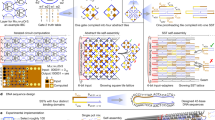
Overview
- Includes laboratory-scale human-operated models of computation; includes the first experiment of DNA computation conducted by Adleman (1994), models to solve complex computational problems, and computationally universal models of DNA computing
- Addresses the design of complex genetic circuits by using cellular logical circuits
Access this book
Tax calculation will be finalised at checkout
Other ways to access
About this book
Sir Francis Crick would undoubtedly be at the front of the line ordering this fascinating book. Being one of the discoverers of DNA, he would be amazed at how his work has been applied to mankind's most important invention, the computer. DNA contains the genetic instructions for the biological development of cellular life forms or viruses. DNA computing uses DNA as a substrate for storing information, while molecular biological operations are used to manipulate this information.
DNA Computing Models begins with a comprehensive introduction to the field of DNA computing. This book emphasizes computational methods to tackle central problems of DNA computing, such as controlling living cells, building patterns, and generating nanomachines. DNA Computing Models presents laboratory-scale human-operated models of computation, including a description of the first experiment of DNA computation conducted by Adleman in 1994. It provides molecular-scale autonomous models of computation and addresses the design of computational devices working in living cells. It also addresses the important problem of proper word design for DNA computing.
DNA Computing Models is designed for researchers and advanced-level students in computers science, bioengineering and molecular biology as a reference or secondary text book. This book is also suitable for practitioners in industry.
Similar content being viewed by others
Keywords
Table of contents (7 chapters)
Reviews
From the reviews:
"The book is very timely and will likely open up this emerging research area to many current and future researchers. Especially for people on the theoretical computer science side of things, DNA computing has the potential to provide many challenging and exciting new problems. … this book appears to be a collection of survey papers on the topic of DNA computing." (Burkhard Englert, ACM Computing Reviews, November, 2008)
Bibliographic Information
Book Title: DNA Computing Models
Authors: Karl-Heinz Zimmermann, Israel Martínez-Pérez, Zoya Ignatova
DOI: https://doi.org/10.1007/978-0-387-73637-2
Publisher: Springer New York, NY
eBook Packages: Computer Science, Computer Science (R0)
Copyright Information: Springer-Verlag US 2008
Hardcover ISBN: 978-0-387-73635-8Published: 02 July 2008
Softcover ISBN: 978-1-4419-4464-1Published: 05 November 2010
eBook ISBN: 978-0-387-73637-2Published: 11 June 2008
Edition Number: 1
Number of Pages: XIV, 288
Number of Illustrations: 20 b/w illustrations
Topics: Computational Biology/Bioinformatics, Pattern Recognition, Computer Applications in Chemistry, Bioinformatics, Biomedicine general



